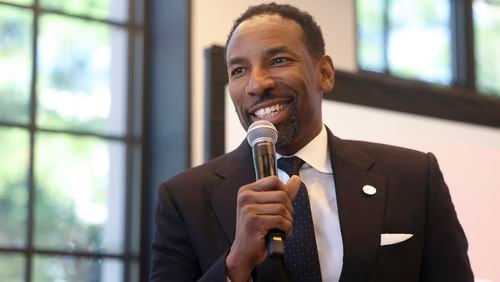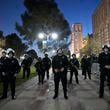As it turned out, Spencer Strider did not necessarily tear the ulnar collateral ligament in his right elbow. When he underwent imaging, the initial X-rays revealed a bone fragment that had formed in his UCL at some point since he underwent Tommy John surgery in 2019.
This was brutal luck: Strider learned there’s probably nothing he could’ve done to avoid the fate he met.
“To be fully honest, I’d been kind of feeling some discomfort back in the spring,” he said. “Every spring, you are building up your throwing capacity, and you’re gonna deal with some soreness and discomfort. It’s part of why we have spring training, why it’s so long. My results and velocity were good enough that I kind of pushed away those apocalyptic thoughts in my mind that something was really wrong. My plan was to pitch if I could be effectively. Ultimately, I couldn’t, so I wasn’t gonna put the team through that.”
And to be clear about the bone fragment: It was a freak incident. This wasn’t the fault of Strider’s surgeon in 2019, who did a great job. The only way to prevent all of this was to never throw again.
On April 12, Strider underwent internal brace surgery to repair his UCL. Dr. Keith Meister performed the procedure in Arlington, Texas.
The internal brace procedure is different than traditional Tommy John surgery: Strider had his UCL fortified with fiber tape (the internal brace) instead of getting a new ligament from tendon graft taken from elsewhere in the body.
On Friday, Strider addressed local media for the first time since reporting elbow discomfort after his April 5 start versus Arizona at Truist Park. He talked about his diagnosis, the emotions that came with it and much more – including the theories people have discussed to explain the rash of pitching injuries.
To a question about why he thinks elbow injuries have become so prevalent, Strider began with this:
“If you got three hours, I’ll sit down and have this conversation. I don’t want to create some soundbite for somebody to turn something into.”
In that spirit, let’s not allow Strider’s words to be minced in any way. Below is everything he said while talking with reporters, though the questions have been edited for clarity.
Q: For starters, how are you feeling?
A: Yeah, I mean, getting better. I had surgery a week ago, so it’s still a little sore, but, it’ll heal.
Q: What were the last couple of weeks like for you emotionally, and how did you attempt to deal with that news?
A: To be fully honest, I’d been kind of feeling some discomfort back in the spring. Every spring, you are building up your throwing capacity, and you’re gonna deal with some soreness and discomfort. It’s part of why we have spring training, why it’s so long. My results and velocity were good enough that I kind of pushed away those apocalyptic thoughts in my mind that something was really wrong. My plan was to pitch if I could be effectively. Ultimately, I couldn’t, so I wasn’t gonna put the team through that. The MRI confirmed that there was something going on. And so, here we are.
Q: The soreness that you had in spring, you thought, ‘This is the kind of thing I can deal with? It’s not a ligament that’s going to break’?
A: Well, I mean, I can’t feel my ligaments. I don’t know. Your arm just doesn’t feel good. There were some days that I thought I was pretty banged up. But like I said, I was effective. You’re not going to feel good playing baseball every day, so I’m not searching for that. Like I said, I’ll pitch through anything if I can help the team. I felt like I couldn’t do that anymore, so I thought it was time to say something.
Q: If you would’ve gone back out there (and continued pitching that night), do you think you could’ve fully torn it?
A: I don’t know how much I should get into the whole thing about it. But I have a bone fragment in my ligament that developed at some point since I had surgery in ‘19, and that essentially destabilized the ligament. My tissue was actually really good. I didn’t have a tear of significance, or really a tear, necessarily. It became a problem, and we had to deal with it surgically.
Q: Could you tell against Arizona the difference between any discomfort you had (on opening day) in Philly and then seven days later?
A: They’re theorizing that I tore some connective tissue between this (bone) fragment and my humerus, and that’s what destabilized the ligament. And maybe I blew through the last of that on that game. Things deteriorated pretty quickly throughout the outing.
Q: How encouraging was it when you knew that you could do this internal-brace procedure instead of Tommy John surgery?
A: It’s not really an either/or, necessarily. I’ve said to people, ‘My check engine came on, and it’s not like they said, ‘We can change your oil or change your whole engine.’ They had to get in there and see. This (bone) fragment kind of concealed the full picture on imaging. Once they got in there, the ligament tissue was even surprisingly good. They cleaned some stuff up and put the brace in. From a recovery standpoint, that’s great. I got to keep a ligament that’s actually pretty solid tissue.
Q: It seems like the internal brace has gotten guys back quicker than traditional Tommy John surgery. How realistic is it to think you could be back toward the start of next season?
A: Yeah, I mean, it’s gonna be a while before I start throwing or anything. But trust the rehab process. They’ve been doing this a lot. Dr. Meister has a great protocol in place for rehab. And fortunately, the calendar works out and such that there’s not a rush of any kind. I’m gonna put that in the trust of the medical staff. Of course, if it was up to me, I’d try to pitch tomorrow.
Q: Did the bone fragment show up on the MRI?
A: Yeah. On initial X-rays, it looked like I’d broke my humerus – I broke the tip of my humerus off, and there’s this big bone floating in my arm. We had to do all of the imaging to understand what it was, and then get in there to see kind of what was really going.
Q: Does it help at all that you’ve been through this process before, so you know what to expect and what to do? (Strider underwent Tommy John surgery in 2019).
A: I think so. A lot of people look at injuries and just adversity in general like it’s a pause on your career. I think that’s dangerous. That implies an assumption that you’re trying to get back, and when you press play again, you’re gonna be the same thing – which, I don’t know why you’d want to be the same thing. If you ask any healthy player, they’re gonna tell you that, in a year from now, they wanna be a better player in every way, a better person. I don’t see an injury as a pause on the timeline or a downward trajectory or anything. I think it’s the same opportunity as you have any day of your life and your career to get better.
Q: Did that pain spring start when you were actually starting to throw in games, or did it start before that?
A: About halfway through spring, it just wasn’t recovering. It got pretty uncomfortable. It kind of came and went between outings. It ultimately was more serious than I thought it might’ve been.
Q: How are you holding up mentally and physically? You were so adamant about this season, the World Series, and now you know you’re not going to be a part of it.
A: Yeah, Yeah. No, I’m not (going to be part of it). These guys don’t need me to win a World Series. They’re gonna pursue that journey, and I’ll be here to cheer them on.
Q: Was there any speculation that picking up a curveball might’ve contributed to the injury?
A: Curveball is not a very – it’s not like I was throwing a splitter or something that was potentially hazardous. This was kind of, to a large degree, out of my control, unfortunately.
Q: When you face adversity, what do you lean on the most or what pushes you to keep going?
A: Same thing that drives your pursuit of greatness every day, and that’s the desire to be good, to win. I don’t see a whole lot changing. It’s just my daily routine. It’s the same goals.
Q: Some people have brought up the pitch clock maybe speeding you guys up a little bit, or the velocity is a lot higher. What are your thoughts?
A: If you got three hours, I’ll sit down and have this conversation. I don’t want to create some soundbite for somebody to turn something into. I don’t even know where to start on the whole thing. There’s so many things that go into it. It’s such a complex situation. I think what’s been frustrating from my end is reading things and seeing people talk, and implying that it’s one thing, or that they somehow are in a position to know why injuries are happening. If we knew, then it’d stop happening. People were getting hurt in baseball way before we were putting velocity on the screen, and I think the environment of the game is such that certain things are valued, and we’re able to understand why velocity is valued, and we can make guys throw harder. But velocity in and of itself, we shouldn’t want guys to stop throwing hard. We should want the environment to be conducive to play health, and I think that that’s a different conversation.
Q: How did it make you feel to be cast as one of those poster children of new-age pitching and injuries and the risk of it, when people didn’t know the full story?
A: Yeah, that was frustrating. Yeah. Whoa. I mean, there’s just so many people in any topic, in any field, that are being a little disingenuous and probably speaking out of their depth, I think. The depth of expertise, I think, is a sad reality for society these days. I’m not saying I am an expert, I’m saying that I just think there’s a lot of people who are quick to assume that they have the answers. The public discourse on this topic matters. That’s what’s frustrating. We want to solve this problem. I also think there’s an element of randomness to injuries. If, instead of the game’s top pitchers, it was a bunch of guys that nobody’s heard of, then I don’t think we’d be having this conversation. I think you need to wait to see the whole season play out. If guys are still getting hurt at the same rate, then yeah, there’s probably a larger conversation that needs to happen. I think there is a conversation that needs to happen because I don’t think (MLB) and other entities are acting in a way that’s conducive to player health and creating a healthy environment.
Q: What do you mean by that? What do you think MLB could do to encourage a more conducive environment for player health?
A: Yeah. Like I said, that’s a long thing. Of course, the pitch clock, the condition of the balls, the banning of substances (that help you) gain a grip, the effective shrinking of the strike zone, for a number of reasons. All those things are playing a factor in injuries. Like in football, people say that, ‘Well, you take the helmets away, then guys will stop getting hurt.’ I mean, that’s pretty silly. Guys are bigger, faster and stronger than they’ve ever been. You can’t take that away. You don’t want guys to compete – be it below their potential, below their ability – just to prevent injury. The environment of the game should be such that guys are able to compete at their highest ability and stay healthy, or have a chance to. It’s a long conversation.
Q: With all the things that have been implied about your injury, what is the one thing you want people to know about this so there isn’t a misconstrued statement?
A: I want them to know that if I could’ve not gotten hurt, I would’ve. I’ve tried. Somebody told me a good analogy one time: Pitchers’ arms are kind of like cars. You go buy a Subaru Outback, I mean, that thing’s gonna run. You can drive it off road, you can beat the crap out of it. I had a Subaru Impreza for a long time. Threw a kayak on top, dented it, put stickers all over it, took it to get maintenance once a year. It’s not flashy, it’s not gonna win any races, but it’s dependable. And then if you buy a Ferrari, you better take good care of it. You gotta do a lot of work, and even still, it might be temperamental, it’s gonna break down. But if you wanna run a race, you want a Ferrari. I think that’s where the state of the game’s at. Teams are looking for Ferraris, and they’re hard to maintain.
Q: How can you still be a part of the team and help the guys, and be around them?
A: That’s something I’m thinking about and want to do, obviously. I’ve been on the other side of injuries where I’m playing. I don’t want these guys to have to devote any attention to me. I certainly don’t want to be a distraction. The best thing I can do is make sure that, when I’m able to play, that I’m effective and I can help the team win. I’m gonna try to stay in the background and whenever I’m needed, in any capacity, of course I’ll do whatever I can. But it’s about the 26 guys that are gonna be rolling out there right now.
Q: Where will you rehab?
A: I plan to stay here (in Atlanta). We’re living here.
Q: When you learned that maybe there was nothing you could do to prevent the bone fragment, how did you deal with the confusion or frustration that comes along with knowing you couldn’t have done anything?
A: Yeah, that’s tough. In 2019 when I got hurt, there were so many things that I had even gained awareness of before I got hurt, and so I was able to immediately focus on preventative measures and moving forward and getting better. That’s the same thing now. Like I said earlier, this isn’t a pause. It is what it is. It’s part of my life. There’s always an uncontrollable element to injuries and to the game, and that’s what makes the game cool. You gotta embrace it and make the most of it.






